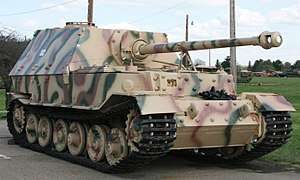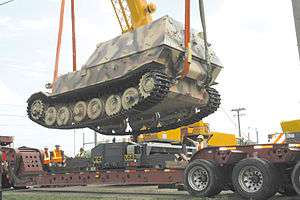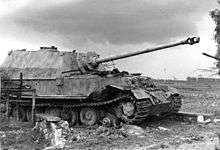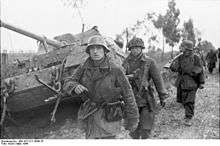Elefant
| Panzerjäger Tiger (P) | |
|---|---|
 The United States Army Ordnance Museum's restored Elefant. | |
| Type | Heavy tank destroyer |
| Place of origin | Nazi Germany |
| Production history | |
| Designer | Ferdinand Porsche |
| Designed | 1942–1943 |
| Manufacturer | Porsche GmbH |
| Produced |
March–May 1943 (modification into Elefant October–November 1943) |
| No. built | 91 |
| Specifications | |
| Weight | 65 tonnes (143,000 lb) |
| Length | 8.14 m (26 ft 8 in) with gun |
| Width | 3.38 m (11 ft 1 in) |
| Height | 2.97 m (9 ft 9 in) |
| Crew | 6 (driver, radio-operator, commander, gunner, two loaders) |
|
| |
| Armor | 200 mm (7.87 in) maximum |
Main armament | 8.8 cm Pak 43/2 L/71, also known as StuK 43/1 |
Secondary armament | 7.92 mm MG 34 machine gun (Elefant only) |
| Engine |
2 × Maybach HL 120 petrol 600 PS (592 hp, 442 kW) |
| Power/weight | 9.2 PS (6.8 kW) / tonne |
| Suspension | longitudinal torsion-bar |
Operational range |
150 km (93 mi) road 90 km (56 mi) cross-country |
| Speed | 30 kilometres per hour (19 mph) |
The Elefant (German for "elephant") was a heavy tank destroyer used by German Wehrmacht Panzerjäger during World War II. Ninety-one units were built in 1943 under the name Ferdinand, after its designer Ferdinand Porsche, using tank hulls produced for the Tiger I tank design abandoned in favour of a Henschel design.
In 1944, after modification of the existing vehicles, they were renamed Elefant. The official German designation was Panzerjäger Tiger (P)[Note 1] and the ordnance inventory designation was Sd. Kfz. 184.
Development history
.svg.png)
Porsche GmbH had manufactured about 100 chassis for their unsuccessful proposal for the Tiger tank, the "Porsche Tiger", in the Nibelungenwerk factory in Sankt Valentin, Austria. Both the successful Henschel proposal and the Porsche design used the same Krupp-designed turret—the Henschel design had its turret more-or-less centrally located on its hull, while the Porsche design placed the turret much closer to the front of the superstructure. Since the competing Henschel Tiger design was chosen for production, the Porsche chassis were no longer required for the Tiger tank project. It was therefore decided that the Porsche chassis were to be used as the basis of a new heavy tank destroyer, Ferdinand, mounting Krupp's newly developed 88 mm (3.5 in) Panzerjägerkanone 43/2[1][2][3] anti-tank gun. This precise long-range weapon was intended to destroy enemy tanks before they came within their own range of effective fire.
Ferdinand was intended to supplant previous light tank destroyers, such as Marder II and Marder III, in the offensive role. A similar gun was used in the lightly armored Hornisse (later known as Nashorn) tank destroyer, built at the same time.
Design
Chassis
The engines had already been placed in the middle of the hull to accommodate the Krupp-designed turret that both the Porsche and Henschel contenders used for the initial Tiger tank contract, and that placement for the Porsche-designed contender gave room on the Ferdinand for the anti-tank main gun armament at the rear. The main armament was mounted in a simple casemate-style box structure, with slightly sloped sides, on top of this chassis. The initial Ferdinand conversions were thus among the first physical examples of what became known as the dedicated Jagdpanzer tank destroyers, all of which had completely enclosed casemates, but which were all designed to have their casemate-form armored enclosures designed as a much more integral component of the vehicle's hull armor from the start. The driver and radio operator were in a separate compartment at the front. As the engines were placed in the middle, the radio operator and the driver were separated from the rest of the crew and could be addressed only by intercom.
Add-on armor of 100 mm was bolted to the front plates, increasing the plate's thickness to 200 mm and adding another 5 tons of weight.
Drive

The two Porsche air-cooled engines in each vehicle were replaced by two 300 PS (296 hp; 221 kW) Maybach HL 120 TRM engines. The engines drove a single Siemens-Schuckert 500 VA generator, which powered two Siemens 230 kW (312.7 PS) output-apiece electric motors, one each connected to each of the rear sprockets. The electric motors also acted as the vehicle's steering unit. This "petrol-electrical" drive delivered 0.11 km/l (909 litres/100 km) off-road and 0.15 km/l (667 litres/100 km) on road at a maximum speed of 10 km/h off-road and 30 km/h on road. In addition to this high fuel consumption and poor performance, the vehicle was maintenance-intensive; the sprockets needed to be changed every 500 km. Porsche had experience of this form of petrol-electric transmission extending back to 1901, when he designed a car that used it.
Suspension for the "slack track" equipped Elefant consisted of six twin bogies (three per side) with longitudinal torsion bars, without any overlapping wheels or return rollers. There are sprockets at both ends of the vehicle. The drive sprockets are at the rear, while the front pair contain a drum brake system.
Armament
The vehicle was fitted with an 88 mm Panzerjägerkanone 43/2[1] gun (early designation 8,8 cm Stu.K. 43/1). This 71 caliber-long gun had originally been developed as a replacement for the 88 mm anti-aircraft gun that had been used against Allied tanks in the Western Desert Campaign and on the Eastern Front. It had a much longer barrel than the L/56 guns, which gave it a higher muzzle velocity, and fired a different, longer cartridge. These improvements gave the 88 mm L/71 significantly improved armor penetration ability over the earlier 88 mm. Although it lost the competition to the 8.8 cm Flak 41 and never became an anti-aircraft weapon, it was turned into the very successful Pak 43 anti-tank gun.
As fitted, the gun was capable of 25° traverse and a similarly limited elevation.
Production
Ninety-one existing "Porsche Tiger" chassis were converted (chassis number 150010 to 150100). The work was completed in just a few months from March to May 1943.
Modification—Elefant
In September 1943, all surviving Ferdinands were recalled to be modified based on battle experience gained in the Battle of Kursk. During October and November 1943, 48 of the 50 surviving vehicles were modified by addition of a ball-mounted MG 34 in the hull front to counter infantry anti-tank threats, a commander's cupola (modified from the standard StuG III cupola) for improved vision, and the application of Zimmerit paste. The improved vehicles were called Elefant, and this became the official name on May 1, 1944.
Possibly as a stopgap before the Elefant modifications were available for the original Ferdinand vehicles, a variant of the rarely seen Krummlauf curved barrel upgrade for the Sturmgewehr 44 assault rifle was created to allow crews of Ferdinands to defend their vehicle without exposing themselves.[4] Three Bergepanzer Tiger or Bergetiger armoured recovery vehicles were built in Autumn 1943 from Tiger prototypes, and one battle-damaged Ferdinand not suitable for the Elefant modification was converted into a Rammpanzer Tiger or Rammtiger, an experimental breakthrough vehicle.[5]
Combat history

Kursk
Ferdinands first saw combat in the Battle of Kursk, where eighty-nine were committed, the largest deployment of the vehicle during its service.
The Ferdinand was optimized for destroying Soviet T-34 tanks and 76.2 mm anti-tank guns from behind the front lines with its 88mm Pak43/2 L/71 at a range of over 3 kilometres, a role which it performed well. However, after advancing through the initial line of Soviet resistance, it was hampered by a variety of flaws, such as the lack of peripheral vision blocks, a rotating turret or even a single machine gun as secondary armament; Soviet infantry, quickly recognizing this flaw, could easily hide in their trenches until the Ferdinand advanced through their lines, then swarm the vehicle with grenades and Molotov cocktails from the sides.
While this proved a significant disadvantage (later partially rectified by the improved Elefant version of the vehicle), a more significant problem at Kursk was mine damage and mechanical failure. Any damage to the tracks or suspension negated the protection of the armor, as crews were forced to dismount and attempt repairs. The extremely heavy weight of the Ferdinand made towing difficult: the standard armored recovery vehicle in German service at the time was the Bergepanzer IV, a variant of the Panzer IV that could tow a single Panzer IV without assistance. It was insufficient for larger vehicles, with a Tiger I heavy tank requiring three Bergepanzer IVs to be towed, and the Ferdinand requiring five linked in tandem to pull the vehicle off the field.
In the initial stages of the Kursk battle, when the Germans were on the offensive, heavy vehicles could be recovered and repaired with relative peace at night; this at first allowed the majority of knocked-out Ferdinands to be rescued, repaired and returned to duty. However, once the tides had turned against the Germans and they fell back on the defensive, with fewer vehicles to spare, functional Ferdinands with minor damage to their tracks or suspensions had little hope of recovery, and crews were usually forced to destroy the vehicle to prevent a mostly intact tank destroyer from falling into the hands of the Soviets.

The units were deployed at a company level, sometimes sub-divided into platoons, with infantry or tanks in accompaniment to protect the flanks and rear of the vehicles. On the attack, this Jagdpanzer was a first-strike vehicle; while in defence, they often comprised a mobile reserve used to blunt enemy tank assaults[6]
Post-Kursk
Although the Elefant modifications improved the vehicles, some problems could never be fully fixed. In 1944, the Elefants served on the Italian front, but were rather ineffective as their weight of nearly 70 tonnes did not allow them to use most Italian roads and bridges. As at Kursk, most Elefant losses were not as a direct result from combat, but resulted when mechanical breakdowns and lack of spare parts compelled their crews to destroy and abandon them. One company of Elefants saw action during the Soviets' January 1945 Vistula-Oder offensive in Poland, and the very last surviving vehicles were in combat at Zossen during the Battle of Berlin.
The Ferdinand may have been the most successful tank destroyer employed during the war in kills per loss, reaching an average ratio of approximately 10:1.[6] During the Battle of Kursk, the 653rd Heavy Tank Destroyer Battalion (German: schwere Panzerjäger-Abteilung, sPzJägAbt) claimed to have knocked out 320 enemy tanks, for the loss of 13 Ferdinands.[7] This impressive average ratio was due to its extreme firepower and protection, which gave it an enormous advantage when used in head-on combat or a static defensive role. However, poor mobility and mechanical unreliability greatly diminished its operational capability.
The Elefant and Nashorn were both superseded by the Jagdpanther. All three vehicles mounted the same gun, with only some minor differences between them. The Jagdpanther was a successor to the other two, combining acceptable mobility and good armour while retaining the great gun, mostly solving the reliability and protection problems that the earlier vehicles had.
Survivors
Only two of these vehicles survived the war. One Ferdinand was captured by Soviet forces at Kursk, and is now at the Kubinka Tank Museum outside Moscow. An Elefant was captured at Anzio by the Americans, and is now part of the United States Army Ordnance Museum's collection at Fort Lee, VA. The example at Fort Lee was restored to display condition in 2007–2008,[8] as documented on the show Tank Overhaul, but not in its original paint scheme. [9]
It was announced in 2016 that the Fort Lee Elefant would be loaned to the Bovington Tank Museum in Dorset, UK. The vehicle would be displayed as part of the museum's "Tiger Collection" display from April 2017. This display aims to bring all the members of the Tiger family together in one place for the first time.[10]
 The United States Army Ordnance Museum's restored Elefant.
The United States Army Ordnance Museum's restored Elefant. The United States Army Ordnance Museum's restored Elefant.
The United States Army Ordnance Museum's restored Elefant. The Kubinka Tank Museum's Ferdinand.
The Kubinka Tank Museum's Ferdinand.
See also
- SU-152, a Soviet self-propelled heavy howitzer which earned the nickname Zveroboy ("beast killer") for its ability to knock out Elefants, as well as Tigers and Panther tanks.[11]
Notes
References
- 1 2 D 2030 – 8,8 cm Panzerjägerkanone 43/2 (L/71), Beschreibung, 28.1.1944. Berlin.
- ↑ D97/1+ Gerätliste, Oberkommando des Heeres Heereswaffenamt, s.45, Berlin 1.7.43
- ↑ "Gerätliste s.45". Archived from the original on 2015-11-17.
- ↑ "Forgotten Weapons: The Nazis' Desperate Attempts to Curve a Bullet". Popularmechanics.com. 13 July 2016. Retrieved 17 August 2017.
- ↑ Rob Arndt. "RÄUMPANZER TIGER (P) : RAMMTIGER (1942–1945)". Strangevehicles.greyfalcon.us. Retrieved 2017-08-18.
- 1 2 "Tank Destroyer Elefant". Germandressdaggers.com. Retrieved 2017-08-18.
- ↑ "Ferdinand/Elephant". Achtung Panzer!. Retrieved 2010-02-07.
- ↑ "Richmond Times Dispatch". Archived from the original on 2013-02-04. Retrieved 2011-04-07.
- ↑ "Picture of the Army Ordance Museums Elefant when captured (can be recognized by the impacts on the gun and on the left front wheel)". Archived from the original on 2016-03-04.
- ↑ "In a world first, The Tank Museum is planning an exhibition that will bring every member of the Tiger Tank family together in one display". Tankmuseum.org. Retrieved 2017-08-18.
- ↑ Green, Michael; Brown, James D. (2008), "Red Army Solutions for the Tiger E Tank", Tiger Tanks at War, St. Paul: Zenith Press, p. 104, ISBN 978-0-7603-3112-5
External links
| Wikimedia Commons has media related to Panzerjäger Tiger (P). |
- Information about the Panzerjäger Tiger(P) "Ferdinand/Elefant" at Panzerworld
- Ferdinand in Kubinka tank museum
- World War II Vehicles
- Achtung Panzer web site.
- Photogallery
- Very large Russian photo gallery (grayknight.narod.ru)
- Elefant at Aberdeen Proving Ground photos @ 5 Star General site
- Photos of disabled and destroyed 'Ferdinands' of 5./schwere Panzerjäger-Abteilung 654 at Ponyri railway station during operation 'Zitadelle'
- The Tank Museum (UK) "Tank Chat #42 – Elefant" Video